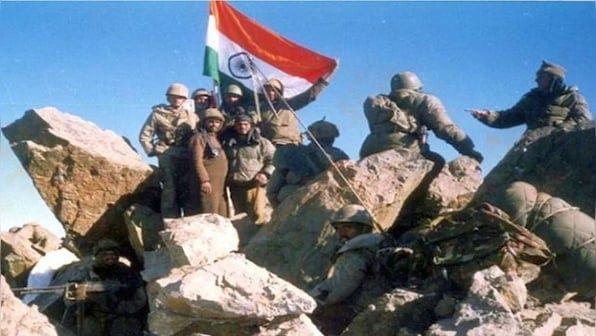Commemorating 25th Anniversary of Kargil Vijay Diwas: Honour and Reflection
Was the top brass of the Indian Army held responsible for the Pak intrusion, even as young officers and jawans exhibited exemplary bravery in snatching a victory against all odds but at huge cost?
Commemorating Kargil Vijay Diwas: 25th Anniversary
As India commemorates the 25th anniversary of Kargil Vijay Diwas on July 26, 2024, it is both a time of solemn remembrance and profound tribute. This article not only reflects on the bravery of Indian soldiers but also scrutinizes the strategic lapses that led to such high costs during the 1999 conflict. It raises pertinent questions about whether responsibility and accountability were adequately assigned at the highest levels of army's top brass.
Tribute to Valour: Saluting the Heroes of Kargil
The Kargil conflict, often remembered for its harsh battlegrounds and the steely resolve of India's armed forces, resulted in the loss of over 500 Indian soldiers, with more than 1,300 wounded. These soldiers fought valiantly in treacherous conditions, recapturing key positions from infiltrators. The nation's gratitude is boundless, and their sacrifice is commemorated with deep respect and honour. Their families' resilience and the survivors' courage embody the spirit of India's indomitable will.
Genesis of the Kargil Conflict
In May 1999, a grave challenge emerged along the Line of Control (LoC) in the stark terrains of the Kargil district, Jammu and Kashmir. Pakistani troops and militants executed a covert infiltration, seizing strategic heights overlooking the vital Srinagar-Leh highway. This manoeuvre not only threatened the lifeline for Indian military forces but was also aimed at severing India’s access to the Siachen Glacier, escalating the stakes by attempting to re-internationalize the Kashmir dispute. In response, India initiated Operation Vijay, a robust military campaign to reclaim the occupied territories. This operation quickly escalated into a full-scale conflict, characterized by intense combat and strategic military engagements. By July 26, 1999, after nearly two months of fierce fighting, Indian forces had successfully ousted most of the intruders, reaffirming India’s control over the region, a day what is observed and commemorated as Kargil Vijay Diwas.
Human and Material Toll of the War
The conflict, while culminating in a strategic victory for India, came at a substantial human cost and disruption. India sustained significant casualties, with over 500 soldiers making the ultimate sacrifice and approximately 1,363 troops sustaining injuries in the line of duty. Estimates of Pakistani military casualties varied widely, ranging from 400 to 4,000 killed. The war also had a severe humanitarian impact, as thousands of civilians in the Kargil region were uprooted from their homes, suffering displacement due to the combat operations. This displacement not only affected the socio-economic fabric of the local communities but also highlighted the dire consequences of military conflicts on civilian populations, reinforcing the importance of peace and stability in the region.
Strategic Oversights: Unpacking the Intrusion
a.) Lack of Coordination between various Wings
The Kargil conflict, despite its eventual successful outcome, laid bare significant lapses within India's intelligence and military frameworks. Initially, the infiltration by Pakistani troops and militants went undetected, a failure attributed to systemic weaknesses in India's intelligence and military vigilance. These lapses were particularly evident in the critical gaps in Indian troop deployments in the Kargil region. These gaps emerged as forces were reallocated to address insurgent activities in the broader Kashmir Valley, leaving vulnerabilities that were not adequately monitored.
b.) Pakistan Strategy was anything but naive
Compounding the issue, these oversights were not merely incidental but were areas that Pakistan had strategically identified and chosen to exploit, maintaining a calculated silence over the years about their knowledge of these vulnerabilities. This strategic oversight by Indian defense setups underscores the pressing need for robust improvements in both surveillance and coordination among the various branches of the military and intelligence agencies. Such enhancements are essential to fortify national security and prevent similar breaches in the future.
Leadership Under Scrutiny: The Role of General Ved Malik
a.) Hogging the Credit?
General Ved Malik, the then Army Chief, praised for leading India to a "victory," has faced criticism for the operational oversights that perhaps enabled the intrusion. While the Kargil Review Committee highlighted merely the “systemic failures”, the absence of individual accountability has raised persistent questions, not only from defence experts but also from retired army officers who saw action. The narrative that only a Brigadier was made a scapegoat, despite ongoing reports of vulnerabilities, suggests a disconnect in the chain of command and highlights the need to re-evaluate leadership responsibilities in critical times.
b.) Where does the buck stop?
Moreover, even 25 years after the intrusion that occurred under his watch, General Malik often publicly praises his own role in the "victory"—a conflict that became necessary only because the infiltration was initially allowed to occur. Reclaiming the lost territory, though commendable, does not negate the initial lapse for which the top Army Chief was not held responsible—perhaps because the then Prime Minister Vajpayee was advised that any such action would demoralize the armed forces that had just recaptured the lost ground in Kargil at a tremendous cost. It is felt that General Malik should remain reserved in his retirement years, as his public appearances can revive memories of his questionable leadership during the conflict.
The Unheard Voice of Brigadier Surinder Singh
a.) Dismissal Under Controversial Circumstances
Brigadier Surinder Singh, the former commander of the 121 Infantry Brigade based in Kargil during the 1999 conflict, has been at the centre of a protracted legal and professional controversy following his dismissal from service in June 2000. His removal under Army Rule 19—which allows the Army Chief to dismiss an officer if conducting a court martial is deemed "inexpedient and/or impractical"—came after two prior courts of inquiry. These inquiries investigated claims of vacating a post and alleged leakage of documents, but neither led to a formal court martial.
b.) Warnings Ignored and Legal Battle Initiated
he heart of Brigadier Singh’s dispute is his claim that he had repeatedly warned of significant vulnerabilities and gaps in the Kargil sector prior to the Pakistani intrusion, yet his alerts were largely ignored. Despite a positive assessment from his commanding officer in July 1999, which commended his handling of the situation once the intrusion was discovered, Brigadier Singh contends that his subsequent dismissal was hastily executed and lacked due procedural justice. His legal challenge began with a writ petition filed in the Delhi High Court in 2002, seeking an independent inquiry and the restoration of his honor and position.
c.) Ongoing Legal Struggle and Unresolved Issues
Now, over two decades later, Brigadier Singh's legal struggle continues without resolution. Although his dismissal was upheld, his pension has been restored, signaling a partial concession by the military. However, the primary goal of clearing his name and fully restoring his reputation and honour remains unmet. This case underscores the broader issues related to the treatment of military whistleblowers and the mechanisms for accountability within the armed forces, highlighting the difficulties faced by those who attempt to avert crises but find their warnings sidelined.
Formation and Objectives of the Kargil Review Committee
The Kargil Review Committee (KRC) was established under the chairmanship of K. Subrahmanyam, a distinguished retired Indian Administrative Service officer and head of the National Security Council Advisory Board (NSCAB) at the time. The committee also included Lt Gen K. K. Hazari, former Vice Chief of the Army Staff; B.G. Verghese, a member of the NSCAB; and Satish Chandra, secretary of the National Security Council Secretariat, who served as the member-secretary of the KRC. The primary mandate of the KRC was to thoroughly investigate the sequence of events and circumstances leading to the Pakistani aggression in the Kargil district of Jammu and Kashmir and to suggest measures to prevent such incidents in the future. Notably, the committee's purpose was not to assign blame to specific individuals or organizations but to conduct a broad review of the national security system and recommend systemic improvements.
a.) Findings and Recommendations of the Kargil Review Committee
The Kargil Review Committee was initially given a three-month deadline to submit its report, which was subsequently extended to December 15, 1999. The committee's findings pointed to significant deficiencies in India's intelligence gathering and the coordination between various agencies. There was a notable lack of coordination not only between the Army and intelligence agencies but also within the Army itself. The KRC cited "systemic failures" as the root cause of these deficiencies, deliberately avoiding the assignment of blame to specific individuals. While the committee's report led to certain reforms in military strategy and intelligence coordination, the absence of direct accountability was met with mixed reactions. The findings have been insightful in highlighting broad systemic issues, yet they also underscore the need for a culture where accountability is both clear and constructive, ensuring that national security is robustly safeguarded against future threats.
b.)Moving Forward: Building a Resilient Defence
As India commemorates this significant anniversary, it's an opportunity to reflect on both the heroic achievements and the painful lessons of Kargil. Strengthening surveillance, improving coordination among intelligence agencies, and ensuring that all levels of military leadership are responsive and accountable are essential steps towards safeguarding the nation against future threats.
Reflection and Accountability on Kargil Vijay Diwas
Kargil Vijay Diwas remains a day of mixed emotions—a day to honor the brave who fought and to reflect on the lessons learned to safeguard the future. It is an opportune moment to address unresolved issues, such as the full exoneration of Brigadier Surinder Singh, whose efforts and early warnings were previously overlooked. This day also serves as a reminder that vigilance, accountability, and honor must go hand in hand in the quest to secure peace and protect the nation. As Prime Minister Narendra Modi prepares to attend the grand yet solemn commemoration on 26th July in Kargil, now in the Union territory of Ladakh, it is imperative that the narrative not be dominated by former Army Chief General Ved Malik, whose leadership during the conflict remains contested. This anniversary should focus on equitable recognition of all levels of service and sacrifice, especially of the young officers and jawans who laid down their lies at the altar of the nation’s territorial sovereignty.








Sir you can mention my name if required
ਮੈਂ ਕਾਰਗਿਲ ਯੁੱਧ ਨੂੰ ਦਰਾਸ ਸੈਕਟਰ ਦੇ ਪਿੰਡ ਬਿੰਬਟ ਦੇ ਸਰਕਾਰੀ ਸਕੂਲ ਵਿੱਚ ਬੈਠ ਕੇ ਆਪਣੀਆਂ ਅੱਖਾਂ ਨਾਲ ਵੇਖਿਆ ਹੈ। ਇਹ ਪਿੰਡ ਟਾਈਗਰ ਹਿੱਲ ਦੇ ਬਿਲਕੁਲ ਪੈਰਾਂ ਵਿੱਚ ਸਥਿਤ ਹੈ। ਟਾਈਗਰ ਹਿੱਲ ਤੋਂ ਪਾਕਿ ਅੱਤਵਾਦੀਆਂ ਦਾ ਕਬਜਾ ਹਟਾਉਣ ਦਾ ਕੰਮ ਭਾਰਤੀ ਫੌਜ ਦੀ 8 ਸਿੱਖ ਰੈਜੀਮੈਂਟ ਨੂੰ ਦਿੱਤਾ ਗਿਆ ਸੀ। ਜੰਗ ਦੇ ਪਹਿਲੇ ਦਿਨ ਹੀ 8 ਸਿੱਖ ਬਟਾਲੀਅਨ ਦੇ 35 ਫੌਜੀ ( ਜਵਾਨ ਅਤੇ ਅਫਸਰ) ਸ਼ਹੀਦ ਹੋ ਗਏ ਸਨ। ਜਦੋਂ ਮੈਂ ਸ਼ਹੀਦਾਂ ਦੇ ਨਮਿੱਤ ਅਰਦਾਸ ਕੀਤੀ ਤਾਂ ਬਹੁਤ ਫੌਜੀ ਗਮਗੀਨ ਮਾਹੌਲ ਨੂੰ ਨਾਂ ਸਹਾਰਦੇ ਹੋਏ ਵਿਛੜਿਆਂ ਦੀ ਯਾਦ ਵਿੱਚ ਰੋਣ ਲੱਗ ਪਏ ਅਤੇ ਕੁਝ ਕੁਝ ਬੇਸੁੱਧ ਵੀ ਹੋ ਗਏ । ਇਸ ਖੇਤਰ ਨੂੰ ਛਡਾਉਣ ਲਈ ਭਾਰਤ ਅਤੇ ਵਿਸ਼ੇਸ਼ ਕਰਕੇ ਸਿੱਖਾਂ ਨੂੰ ਭਾਰੀ ਕੀਮਤ ਅਦਾ ਕਰਨੀ ਪਈ ਸੀ।